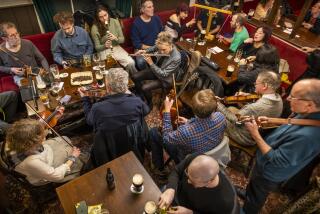Oh, to Be in London During the Year 1600
- Share via
How about a trip to London for the holidays.
Wait a minute--it’s free! The Francis Bacon Library in Claremont has arranged it all for you.
Take off in the morning or afternoon and it’s there all ready for you, a complete tour of London in the year 1600--you might even catch a glimpse of the queen, Elizabeth I. You’ll pass among the throngs on the streets, take in the new plays--”Much Adoe About Nothing” “The Cronicle History of Henry the Fifth, 1600” or “A Midsummer Night Dreame” at the just-built (at a cost of 440 pounds) Globe Theatre. You’ll visit the famous shopping centers, the Red Lion with “a great lion of timber placed there at the gate . . . divers fair and large shopes” and the Rodeo Drive of London, all the shops on London Bridge.
You’ll marvel at the men’s and women’s fashions, dresses with peaked stomachers, farthingales, neck ruffs. Most of the fashionable women have blond hairdos, and you can be blond too by taking “the rine or scraping of rubarbe, and stiepe it in white wine, or in cleere lie.” You may wish to curl it too with “ashes of burned sheep’s horn, mixed with oil.”
You may select from periwigs, perukes, gregorians, although you will be criticized by pamphleteer Philip Stubbes, who had written that they were not worn by women who had lost their hair, but by those who were too lazy to care for it, those who “will not looke to it, combe it, picke it, wash it, makes it a cluster of knottes, and a feltryd borough for white-footed beastes.” You’ll notice that orange-tawny is a very popular hair tint for men. If you have all your hair and teeth and have not contracted smallpox, you will already be beautiful but may wish to buy sublimate of mercury for a face peel or white lead for whitening, belladonna for the eyes and perhaps some brick dust for brushing your teeth.
You’ll want to see the royal lions in the Tower of London along with the leopards and elephants given by foreign rulers.
Itinerant booksellers will offer their wares or you browse at more stationary stationers. St. Paul’s Cathedral must not be missed, although the spire struck by lightning in 1561 has not been replaced.
You might take a carriage for a side trip to Westminster (a few miles from London). John Stow tells us notable things to see in Westminster include the wool staple, the Abbey Church, three royal palaces--St. James (formerly a hospital for leperous virgin maidens now a fair manor and park), Whitehall and Westminster Hall. Consult Stow’s 1598 book, “Survey of London,” for other sights to see.
Another trip would be to the suburbs outside London’s walls such as Chelsea where, W. C. Hazlitt writes, “The manner of the most gentlemen and noblemen is to house themselves (if possibly they may) in the suburbs of the city, because the air there being somewhat at large, the place is healthy” and “the noise not much.” Interesting outlying villages would be Richmond, Twickenham or Greenwich.
For medical emergencies there are barber-surgeons who will bleed you or saw off a wounded limb; the apothecary shops carry pills made from skulls of hanged men, powder of mummies, entrails of wild animals, and healing oil of scorpions or spring water from skulls of murdered men. Tumors can be cured by stroking them with the hand of a dead man.
There are plenty of splendid hostelries on the great thoroughfares able to accommodate your horses and servants, numerous taverns--the Bar of Ye Olde Cheshire Chees, Mermaid Tavern, the Noisy Devil, Crosby Place, Ye Olde Boar’s Head among them or, if you feel casual, you can choose from street vendors crying “hot ribs of beef” or “pies baked well.”
For entertainment there are the theaters (banned within the city as corruptors of youth with their unchaste and wicked matters) encouraging pickpockets and lowlife actors and the bowling alleys that Stephen Gosson in his “Schoole of Abuse” warned us in 1579 “are privy moths, that eat up the credit of many idle citizens.” Archery, wrestling, football, cockfighting, and bull-baiting are enjoyed. The bear garden sees bear-baiting to the disapproval of Philip Stubbes, who has written in his 1583 “The Anatomie of Abuses”: “Although they be bloody beasts to mankind, and seek his destruction, yet we are not to abuse them, for his sake who made them and whose creatures they are.”
London--”far that rings through regions large” Ralph Agas penned on the map he drew in the late 1500s. John Stow, a self-educated tailor, put down his needle at age 40 to research and chronicle London life. It consumed him. He published 11 editions of his chronicles, edited an edition of “Canterbury Tales” and, when his patron died, fell into poverty. In the last year of his life, King James I rewarded him by granting him a license to beg; if you see him, in his late 70s, give him a farthing.
His book, “Survey of London 1598,” is at the Francis Bacon Library in Claremont for you to see along with the display, London: A Tourist’s Guide to the Year 1600. Librarian Jacqueline Bellows has put it all together with assistant Bonnie French, and they will be happy to guide you anytime Monday through Friday, 9 a.m. to 4:30 p.m. through Dec. 6. Information: (714) 624-6305.
More to Read
Sign up for The Wild
We’ll help you find the best places to hike, bike and run, as well as the perfect silent spots for meditation and yoga.
You may occasionally receive promotional content from the Los Angeles Times.






